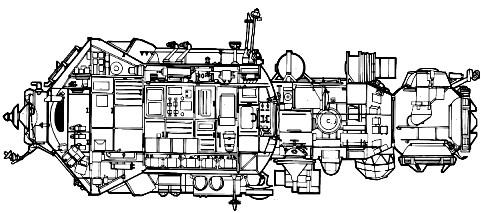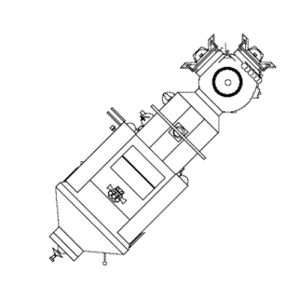
Home - Search - Browse - Alphabetic Index: 0- 1- 2- 3- 4- 5- 6- 7- 8- 9
A- B- C- D- E- F- G- H- I- J- K- L- M- N- O- P- Q- R- S- T- U- V- W- X- Y- Z
Kristall

Kristall Cutaway
Kristall is the third addition to the Mir core vehicle. Kristall is divided into an instrument/cargo and instrument/docking compartment.
AKA: 11F77T;Timofei;TsM-T 77KST-17201. Status: Operational 1990. First Launch: 1990-05-31. Last Launch: 1990-05-31. Number: 1 . Payload: 7,000 kg (15,400 lb). Gross mass: 19,500 kg (42,900 lb). Unfuelled mass: 17,000 kg (37,000 lb). Height: 11.90 m (39.00 ft).
Originally the modules attached to the Mir base block were to be of the NPO Energia 37KS design. Design and fabrication reached an advanced phase when it was decided that the separate tug concept resulted in too low a net scientific payload (3 metric tons). Integrating the tug with the module was expected to increase this to 5 metric tons and provide some reserve engine capability at Mir and additional pressurized volume. Accordingly the 37KS modules for Mir were cancelled in 1983. Competitive designs for integrated space station modules were submitted by KB Salyut and NPO Energia. The KB Salyut 77K modules were derived from the cancelled TKS manned ferry. The competing proposal from NPO Energia combined the 37KS module with the engine unit of Mir. In June 1984 the KB Salyut design was selected. The revised Mir program plan was to assemble the station over a three year period, and operate it for ten years (versus the original one year/five years).
Kristal was a dedicated zero-gravity materials and biological science research module. It was to have been launched to Mir ten months after Kvant-2, in December 1989, but problems with the Kurs automatic rendezvous and docking system resulted in it being launched in January 1990, just over a month after Kvant-2.
Description
Kristal was the third addition to the Mir core vehicle and was primarily designed to investigate materials processing technologies in the space environment. The module also supported biological, Earth observation and astrophysical research. The module originally docked with the station on June 10, 1990 at the Mir forward axial port. After that it was moved several times by the small manipulator arm on Mir to accommodate the addition of the Spektr module to the station and to allow rendezvous with the US Shuttle at Kristal's main docking port. The module was transferred to its final location at the Mir transfer compartment's starboard radial port on July 17, 1995.
Kristal had 61 cubic meters of total pressurized volume and was divided into two compartments. The Instrument-Payload Compartment housed food containers, and the industrial processing equipment Krater 3, Optizon 1, Zona 02, and Zona 03. An 0.8 m hatch led to the Junction-Docking compartment. This contained a spherical universal docking system with two APAS-89 androgynous docking units. One was to have been used to dock with the cancelled Buran space shuttle, which would have left behind a 1,000 kg X-ray telescope in 1991. Instead it was used for the first Shuttle/Mir rendezvous in 1995. A special Docking Module was delivered to the station to accommodate subsequent Shuttle visits. A third opening housed earth observation cameras.
Kristal was originally equipped with two solar panels (72 sq. m total area) that provided up to 8.4 kW. Unlike the other solar panels on the Mir Complex, these could be folded or unfolded as a function of electrical power requirements. One of these panels was moved to Kvant in 1995 at NASA's insistence before the start of Shuttle-Mir docking missions. A 360 A-hr NiCd battery system provided energy storage. Propulsion during rendezvous and docking with Mir consisted of two 3.9 kN main engines (N2O4/UDMH) and clusters of 400N attitude control thrusters.
Equipment delivered with Kristal included:
- Krater 5, Optizon 1, and CSK-1/Kristallizator semiconductor materials processing furnaces.
- Zona 2/3 materials processing furnaces.
- Glazar 2 UV telescope - cosmic radiation studies.
- Priroda 5 Earth resources camera system - consisted of 2 KFA-1000 film cameras.
- Svet plant cultivation unit.
- Mariya magnetic spectrometer.
- Marina gamma ray telescope.
- Buket gamma ray spectrometer.
- Granar astrophysics spectrometer.
- Ainur electrophoresis unit.
More at: Kristall.
Family: Soviet Space Stations, Space station, Space station orbit. Country: Russia. Spacecraft: Mir, Mir complex. Launch Vehicles: Proton, Proton-K. Launch Sites: Baikonur, Baikonur LC200/39. Agency: Chelomei bureau, MOM. Bibliography: 182, 2, 20, 274, 453, 6, 67, 8, 6638, 12743.
 | Kristall Large Credit: © Mark Wade |
 | Kristall Credit: © Mark Wade |
 | Kristall Credit: Manufacturer Image |
1983 November - .
- 37KS Modules for Mir cancelled, replaced by FGB modules. - .
Nation: Russia.
Spacecraft: 37KS,
Kristall,
Kvant,
Kvant-2,
Mir,
Priroda,
Spektr.
Design and fabrication reached an advanced phase when it was decided that the separate tug concept resulted in too low a net scientific payload (3 tonnes). Integrating the tug with the module was expected to increase this to 5 tonnes and provide some reserve engine capability at Mir and additional pressurised volume. Accordingly the 37KS modules for Mir were cancelled. Work on the 37KE experimental module (Kvant) and the 37KB Buran modules continued. The function of the 37KS modules was taken up by modules by KB Salyut derived from the FGB. A competing proposal from NPO Energia for a unified spacecraft that combined the 37KS module with the engine unit of Mir was rejected.
1990 May 31 - . 10:33 GMT - . Launch Site: Baikonur. Launch Complex: Baikonur LC200/39. LV Family: Proton. Launch Vehicle: Proton-K.
- Kristall - .
Payload: 77KST s/n 17201. Mass: 19,640 kg (43,290 lb). Nation: Russia.
Agency: MOM.
Program: Mir.
Class: Manned.
Type: Manned space station. Flight: Soyuz TM-9.
Spacecraft Bus: Mir.
Spacecraft: Kristall.
Decay Date: 2001-03-23 . USAF Sat Cat: 20635 . COSPAR: 1990-048A. Apogee: 397 km (246 mi). Perigee: 388 km (241 mi). Inclination: 51.60 deg. Period: 92.40 min.
Mir module; materials processing laboratory. Docked with Mir. Kristall: Mass: 19,500 kg. Mass on docking 17,200 kg. Length: 11. 9 m or 13. 73 m?. Solar array span 36 m. Diameter: 4. 35 m. Payload: 7,000 kg. Two compartments. Instrument-Payload Compartment contains food containers, and industrial processing units Krater 3, Optizon 1, Zona 02, and Zona 03. 0. 8 m hatch leads to Junction-Docking compartment. This contains spherical universal docker with two APAS-89 androgynous docking units. These will be used to dock with Buran shuttle and 1,000 kg X-ray telescope to be delivered by Buran in 1991. Third opening houses earth observation cameras.
Launch originally planned for 30 March 1990. Delayed to April 18, then further delayed due to computer chip problems.
Launched 31 May 1990 12:33 GMT. Docking scheduled June 6 at 12:36 but delayed due to problem with one of Kristall's orientation engines. Docking successful 10 June at 12:47. On June 11 moved to side port. Work within module began 15 June.
Spektr: Late 1991 launch. Remote sensing work. Occupies port opposite Kvant 2. Before this occurs Kristall solar arrays will be relocated to Kvant.
Officially: Specialized module. Experimental-industrial production of semi-conducting materials; refinement of biologically active substances for the production of new medicinal preparations. Cultivation of crystals of different albumine compositions and hybridizatio n of cells. Conduct of astrophysical and technical experiments.
1995 June 10 - .
- Spektr module docks with Mir - .
Nation: Russia.
Flight: Soyuz TM-21.
Spacecraft Bus: Mir.
Spacecraft: Kristall.
After that it was moved several times by the small manipulator arm on Mir to accommodate the addition of the Spektr module to the station and to allow rendezvous with the US Shuttle at Kristall's main docking port. The module was transferred to its final location at the Mir transfer compartment's starboard radial port on July 17, 1995.
Back to top of page
Home - Search - Browse - Alphabetic Index: 0- 1- 2- 3- 4- 5- 6- 7- 8- 9
A- B- C- D- E- F- G- H- I- J- K- L- M- N- O- P- Q- R- S- T- U- V- W- X- Y- Z
© 1997-2019 Mark Wade - Contact
© / Conditions for Use